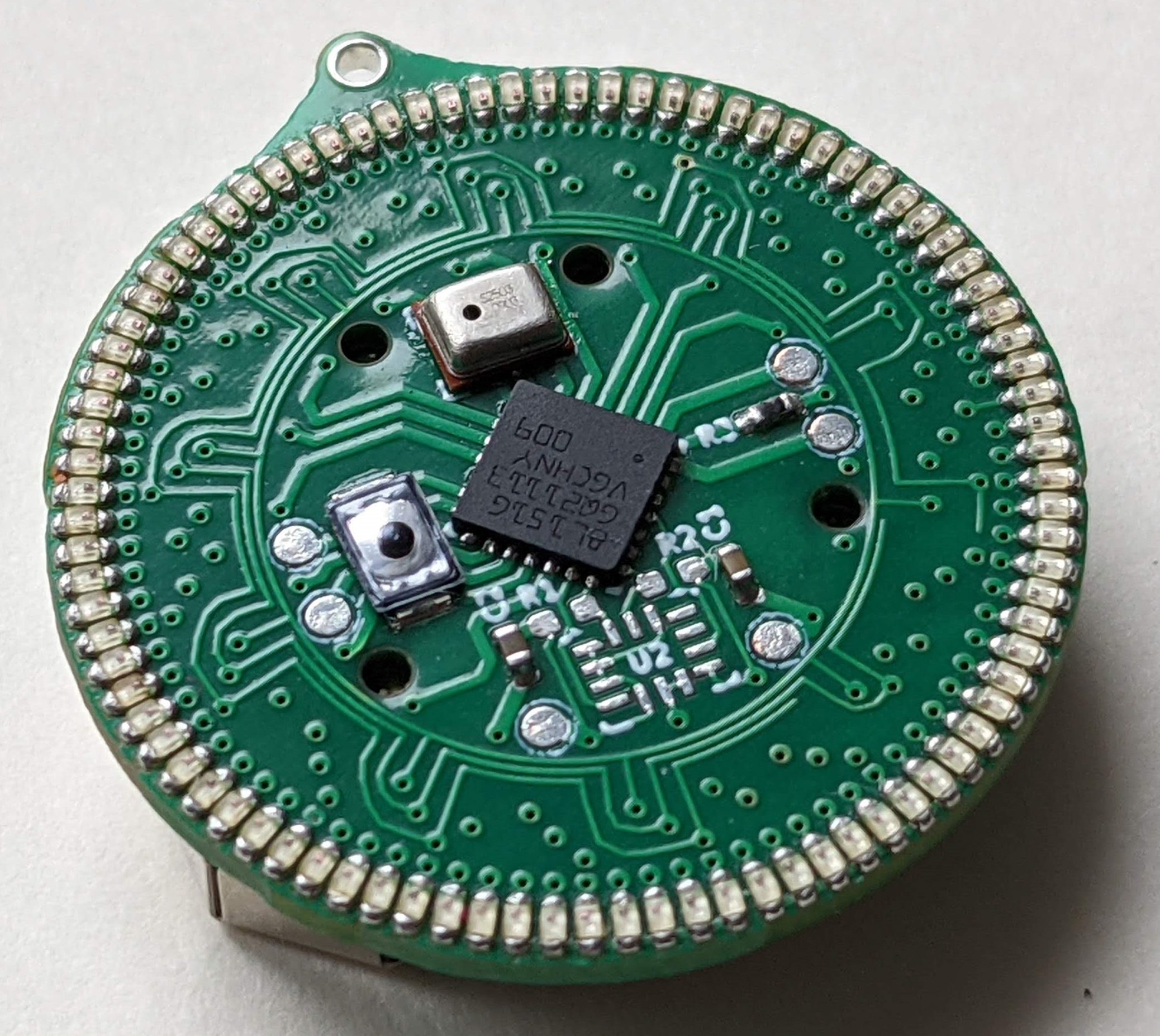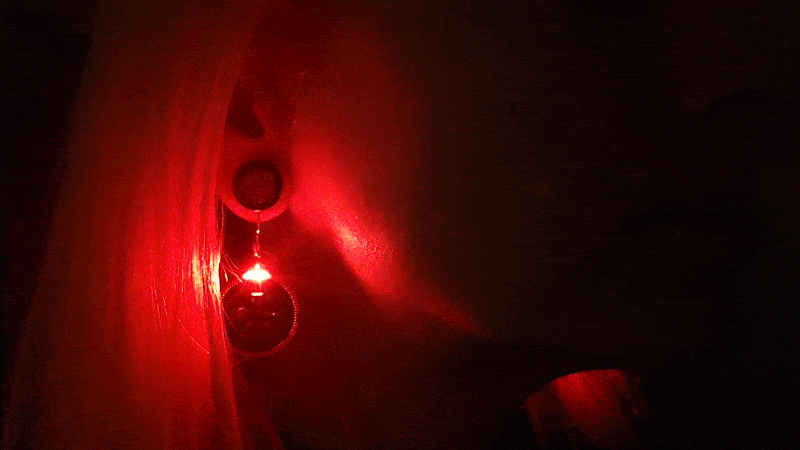Few things get a Hackaday staffer excited like bunches of tiny LEDs. The smaller and denser the better, any form will do as long as we can get a macro shot or a video of a buttery smooth animation. This time we turn to [Sawaiz Syed] and [Open Kolibri] to deliver the brightly lit goods with the minuscule HALO 90 reactive LED earrings.
The HALO 90’s are designed to work as earrings, though we suspect they’d make equally great brooches, hair accessories, or desk objects. To fit this purpose each one is a minuscule 24 mm in diameter and weighs a featherweight 5.2 grams with the CR2032 battery (2.1 g for the PCBA alone). Functionally their current software includes three animation modes, each selectable via a button on device; audio reactive, halo (fully lit), and sparkle. Check out the documentation for details on expected battery life in each mode, but suffice to say that no matter what these earrings will make it through a few nights out.
In terms of hardware, the HALO 90’s are as straightforward as you’d expect. Each device is driven by an STM8 at its maximum 16MHz which is more than fast enough to keep the 90 charliplexed 0402 LEDs humming along at a 1kHz update rate, even with realtime audio processing. In fact the BOM here is refreshingly simple with just 8 components; the LEDs, microcontroller and microphone, battery holder and passives, and the button. [Sawaiz] even designed an exceptionally slick case to go with each pair of earrings, which holds two HALO 90’s with two CR2032’s and includes a magnetic closure for the most satisfying lid action possible.
As with some of his other work, [Sawaiz] has produced a wealth of exceptional documentation to go with the HALO 90’s. They’re available straight from him fully assembled, but with documentation this good the path to a home build should be well lit and accessible. He’s even chosen parts with an eye towards long availability, low cost, and ease of sourcing so no matter when you decide to get started it should be a snap.
It was difficult to choose just a few images from [Sawaiz]’s mesmerizing collection, so if you need more feast your eyes on the expanded set after the break.


















They’d make terrible broaches. Nowhere near sharp enough. Brooches, on the other hand… :-)
Haha, excellent catch! It would be quiiiiite difficult to use these as broaches!
Wow. That’s what i call a documentation! Also the programming jig(?) is a perfect example for “what a 3D printer is useful for?”.
True and true. I wish everything out there that claim to be “universal” and to “set standards to allow device interoperabity” or that claim to “make tech easy and accessible” would be as documented as this lil project.
Thanks, it makes me quite happy whenever someone reads though the docs, probably becasue of the hours I put into writing it, and the hope that other people will be inspired to follow with beautiful docs.
I love the hardware design. What a great use for Charlieplexing.
It’s not charlieplexing. Just look at the schematic.
Ah, heck, nevermind. I goofed. It is. A very neat implementation.
Still can’t wrap my head around this trend of just labeling lines instead of drawing the connection on the schematic. Sure, easier to draw, cleaner to see, but it makes following a schematic much harder.
It’s not a trend. That’s how I did it designing 486 based CNC boards in the late 80’s. Only the simplest and straight forwardest designs did without named nets. They are also mandatory when doing iterative board design. Without named nets, your routing would be ripped out with every change in the schematic.
All true. But when you carry it to the extreme Where. Every. Darned. Component. Gets. Its. Own. Functional. Block, it makes it a pain in the butt to follow signal paths. Tolerable and necessary in complex digital designs, but that affectation especially obfuscates analog designs.
I can’t imagine drawing a charlieplexed array without using nets. The less global net markers I use, the harder the sechematic ends up being to read. Of course would never do such a thing on a analog section since that’s just confusing.
Interesting and arty – made a similar, but much more simple, set of ear rings with the niece some years back using an atmel 2313.
About their compliance statements. The ‘CE’ mark is not any form of certification – it is a declaration that states the basis for a presumption of conformity to scoped directives. The presumption can be based on 3d party test certificates or from a TRF.
WEEE and REACH are not marking directives. ROHS *is* a marking directive, so would have to be listed in a declaration of conformity. The LVD, EMC, and RED directives are the most common for electrical stuff, but these are not scoped for the intended end-use. The battery and general product safety directives could be scoped; and the toy directive would be a bit of a stretch, but I have seen it used for some kids’ jewelry.
This is actually very helpful, thanks. I have very little experience in what it takes to take hardware to market and really want to use this as a way to learn the ropes before delving into making things that need RF approval. I’ll have to start reading up on these things again.
The “halo” in the title made me think it was going to be Halo related, and now all I can think of seeing them in action would be having them flash the Red Ring of Death.
Wow, and I was pleased with myself for doing a compact routing out 20 charlieplexed LEDs in a ring around an encoder with a SAMD10 on the back of the board.
Very cool, lots to learn from here.
$120, okay..
The files are right there on github if you want a cheaper alternative :)
I’m not super happy with the price either, but it’s a reasonable point at the moment to try and recoup my development costs (just the hardware, not even my time). Am aiming to try and drive it down below $50 in the next few years, so I can make it more acessible, but right now with the semiconductor shortage, increse in assembly costs, and slow shipping due to COVID, it’s the best I can do. BOM is only like $40 at qty 2, and the scientist part of me would love to see if its reproducable or if I need to add more to the docs ;)
These are a unique piece and I think the price is totally reasonable. They are a bit expensive, but jewelery in general is expensive. You also made them open source, so it’s fair for you to value your time when setting your price.
Thanks for making this, and the great documentation!
Been looking at the PCB and boy did they do a mind blowing job getting that on a 4 layer PCB (there are some images in docs/layers ).
Agreed! Every layer is even aesthetically pleasing. A very nice job throughout
Thanks! I wrote code in javascript to hande the layout and charliepexing since KiCad aint too good at making curves and my mind isnt good at handling charlieplexing. There was even some more grandiose routing planned but had to settle since the math and logic got too complicated.
Interesting! Is that somewhere we can look at it?
Yeah, in pcb/halo.js. I don’t know how readable it is since it was thrown together as a utility. But it does have variables to increase the diameter and add more LEDs.
https://github.com/openKolibri/halo-90/blob/master/pcb/halo.js
I thought “Hey, that would be really cool if they could have added in an accelerometer.”
Then I saw the unpopulated U2 IC and wondered “Hmm, what’s that for?”
Then I looked at the schematic. :-)
I finally comprehend fashion… thank you makers.
“Due to COVID-19, international shipping is limited to by sea. Transit times may be 1-2 months.”
Huh? Can only be shipped by sea? I don’t think so…
So its part of the whole mess. Deutsche Post, the shipper that has reasonably priced international goods shipping, due to the limited cargo capacity because of less passenger flights is shipping goods packages via sea, ones they normally ship via air. No other good options exist, especially since I’m not charging any extra for shipping.
The next best option is DHL Premium for $40 (where they do not give a delivery time, but promise its sent by air) or UPS with I think a 3-7 day delivery time, for a 100g package they are asking $135. I guess if someone really wanted to do that, it would be an option, but I don’t want to setup a multi carrier shipping system for that just yet.